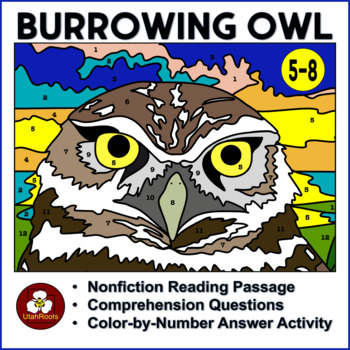Burrowing Owl Nonfiction Reading Passage, Worksheet and Color-by-Number Activity
- PDF
What educators are saying
Learning Objective
Students will learn about the characteristics and adaptations of burrowing owls as well as the threats to the habitat of the burrowing owls.
Description
This resource contains a non-fiction reading passage (two pages – 720 words) about burrowing owls, comprehension questions about the reading, and a color-by-number answer sheet for students to color based on their answers to the comprehension questions. The passage was written specifically to be useful as a paired text for use with the book Hoot by Carl Hiaasen but can definitely be used as a stand-alone reading passage to integrate science with ELA and give students opportunities to read nonfiction high-interest text.
The reading passage is on approximately a 5th-6th grade reading level. You can determine whether or not the reading level is appropriate for your particular students by clicking on the “preview” button above. You’ll be able to see enough of the text in the preview to make a determination about its usefulness in your classes. AI has not been used in the creation of this product.
Students LOVE color by number activities and will stay much more engaged in reading if their work includes coloring! I’ve had teachers from elementary to high school report that my color by number activities are loved by their students, and keep them much more engaged in learning than any traditional worksheet will do.
Another benefit of this resource is that it’s perfect for those unexpected times when you need a lesson for a substitute teacher that is related to your topic of study because it doesn’t require that the substitute have a background in science. All the information students need to complete the work is in the reading passage. It’s also a very useful resource for reading teachers who need high-interest materials for upper elementary and middle school readers, or for high school students who are struggling readers.
Are you looking for a complete unit bundle for teaching Hoot? I highly recommend this one from The Teaching Bank: Hoot Novel Study Book Unit. It has everything from vocabulary and comprehension work to assessments in both printable and Google Drive compatible formats.
You might also be interested in my Red Fox Nonfiction Reading and Color-by-Number resource.
See ALL of my non-fiction reading passage resources by clicking HERE. Or click on any individual resource link below:
Resources marked with an asterisk include a color-by-number component.
Red Fox *
Rabbits and Hares
Natural Disasters
Epidemics
The Elements
Inventors and Inventions
Impossible Dreams: Biographies for Science
Desert Biome *
Taiga: The Boreal Forest *
Rainforest Biome *
The Tundra *
Terms of Use
The color by number puzzle in this product is for personal use by one teacher with his or her students. It may not be used to create products for sale. It may not be distributed to any other person, either digitally or in printed form. Doing so would be a violation of copyright law.





